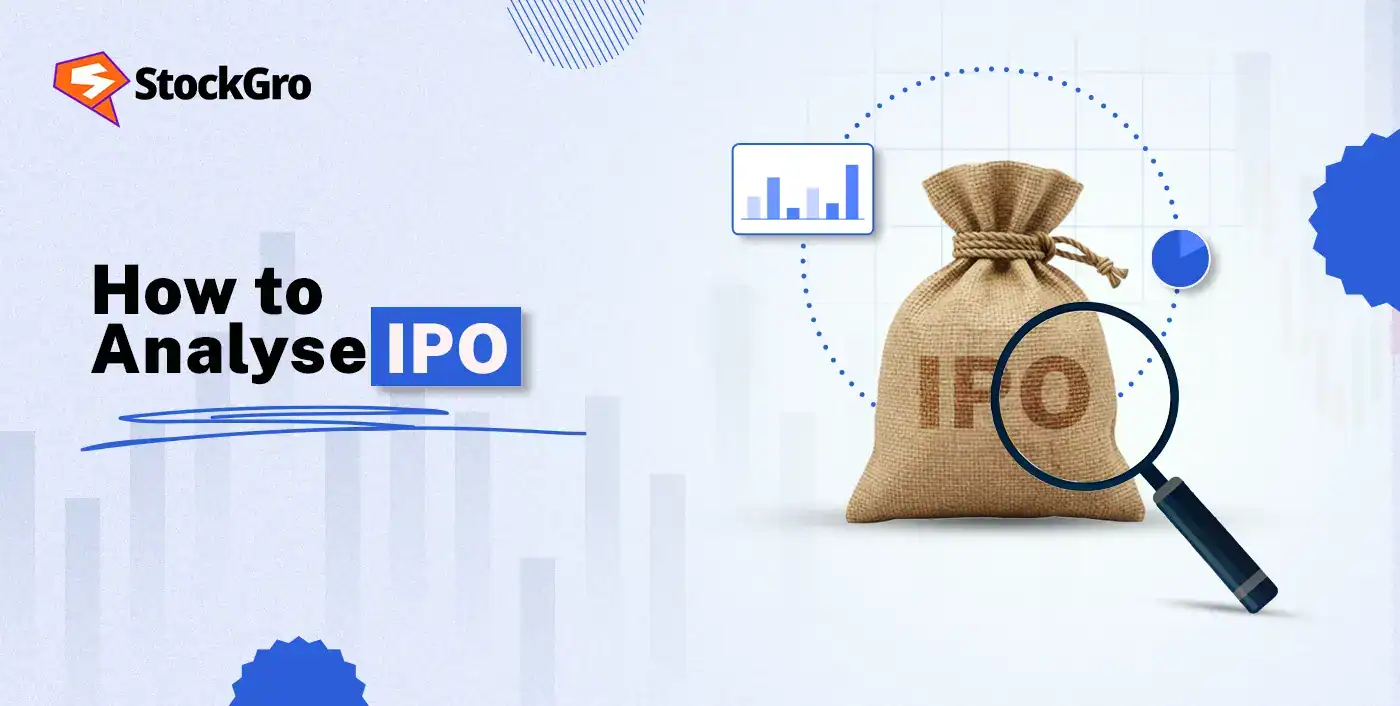
Investing in IPOs is a great opportunity to be a part of a company’s growth journey. An IPO provides investors access to look inside the business, like its financials and fund utilization plans, before investing. India launched 108 IPOs in the first half of 2025 raising ₹40,401.8 Cr with a total of 45 upcoming IPOs in 2025, which include companies like Boat, Flipkart, Tata Capital, PhonePe, etc.
This blog helps in understanding the essentials like DRHP, financials, valuation, management, industry trends, and potential red flags to boost confidence for making informed IPO investments.
How to Analyse IPO
An Initial Public Offering or IPO takes place when a private company decides to go public to raise capital by selling its private shares.
The company generally hires an investment bank or underwriter that buys a portion of its shares at a predetermined price. Once the purchase is made, the shares are listed on the stock exchange, where they can be bought and sold.
However, investors cannot rely on past performance, since there is no previous trading history. Investors solely rely on the fundamental analysis of the company.
Let’s dive into learning how to proceed with IPO analysis steps!
Step 1: Read the DRHP / Prospectus
The Draft Red Herring Prospectus or DRHP is an important instrument that provides precise information regarding the company offering an IPO. This comprises the financial health of the company, its market outlook, and the upside possibilities. DRHP is accessible on the SEBI website and the company website. However, this prospectus may not point out possible risks..
Step 2: Evaluate Company Fundamentals
Since there is no prior trading performance, investors rely on fundamental analysis of the company. Investors can evaluate the growth in revenue, whether there’s steady growth or not, which indicates stability; consistent growth in profit margins, and the financial ratios like debt-to-equity ratio and P/E ratio.
Step 3: Assess Valuation
Investors shall assess if the IPO price is reasonable, and not overvalued or undervalued, by analysing the net worth and the financial ratios like Price-to-Earnings (P/E), Price-to-Book (P/B), and also compare with competitors in the same sector. Investors can also value assets through AI research platforms.
However, a high valuation of the shares might be reasonable if the company has remarkable growth prospects, but it may also affect returns. This IPO valuation guide provides insights for recent IPOs in the same industry to analyze price movements.
Step 4: Understand IPO’s Purpose
IPOs are offered to raise funds for specific reasons. Companies often aim to expand operations, invest in human resources, or use them in general management purposes; these are usually considered positive signs for investors. Some companies may even use the fund to repay debt.
For better information, investors can check the “Use of Proceeds” section in the prospectus. A company that raises funds for expansion is usually a better long-term investment.
Step 5: Review Management & Governance
The management plays an important role in the growth and performance of a company. Key factors to be checked by the investor are the past performance and experience of the management and the promoters. This will give perspective on where the company is heading. Investors must be aware of any legal or regulatory obligations of the company.
If the management is ethical and has favourable governance, it boosts investor confidence and reduces the risks of misleading management.
Step 6: Check Market & Industry Context
At times, a company may struggle if its industry is in a downturn, even though it is stable. Investors should investigate whether the industry is growing or saturated and analyze macro-economic factors(PESTEL). Investors should also consider global events that can directly affect the business and check market conditions through stock market AI
Step 7: Consider Underwriter & Risk Factors
The underwriter or investment banker serves an essential role in setting the price of each share and launching the IPO. A recognised underwriter appeals to institutional investors and improves price stability.
At the same time, reading the detailed risk factors mentioned in the prospectus is equally important. These usually include customer or supplier lists, debt levels, pending legal cases, or exposure to regulatory changes. Understanding these helps to align potential rewards against risks.
Step 8: Use Fundamental Analysis Framework
Now, fundamental analysis differs across industries. Which means the analytical insights from the financial ratios or valuation will differ as well. For instance, the manufacturing industry relies more on physical assets, so metrics such as Return on Assets (ROA) are significant.
Similarly, the tech industry’s main focus is revenue growth, so revenue from operations, EBITDA, and net profits hold more importance. For real estate, Funds From Operations (FFO) gives a clear picture of its revenue generation, and for retail and banking sectors, Same-Store Sales Growth and Net Interest Margins(NIM) indicate growth and profitability, respectively.
Knowing what to check before IPO investment provides clear, fact-based decisions and reduces mistakes driven by hype.
Step 9: Beware of Hype & Grey Market
Grey market premium(GMP) functions beyond regulatory bodies, raising the risks of speculation. This doesn’t indicate real information regarding the company but is driven by hype and fake demand. High GMP does not ensure profitability. In contrast, IPOs with high GMPs might underperform or decline after listing.
Investors should be aware of this hype and take sound decisions while investing in IPOs.
Bottom Line
Understanding how to analyze an IPO can be rewarding. In order to make informed decisions, investors should evaluate the DRHP, fundamentals, valuations of shares, alongside management performance, and consider industry challenges.
Therefore, a well-structured and disciplined approach will help to spot promising opportunities and confidently participate in a company’s growth journey to convert possible risks into smart investment choices.
FAQs
Before investing in any IPO, investors must carefully read and understand the DRHP and the fundamentals of the company offering the IPO.
Investors shall compare the competitors in the same industry and analytically compare their P/E, P/B, and EV/EBITDA.
Insiders might try to sell their shares immediately after listing. In order to prevent that and flooding the market with too many shares, the IPO lock-up period is important.
No, GMP does not indicate listing performance; they are rather driven by hype and fake demands.
Legal or regulatory disputes, company debts, and customer-supplier concentration.
A recognised underwriter appeals to institutional investors and improves price stability.
If the promoter holdings are high, it reflects commitment. However, a significant reduction in promoter holding or share pledging could raise warnings.

Leave a Comment